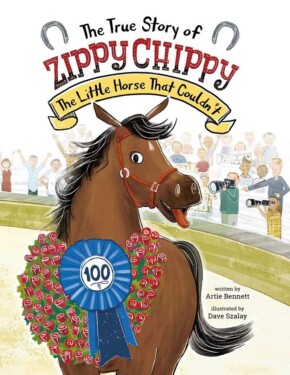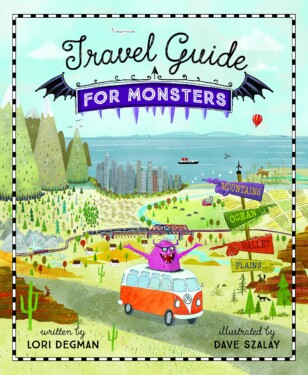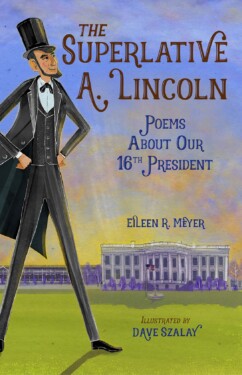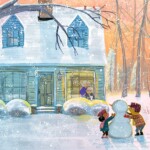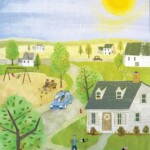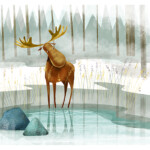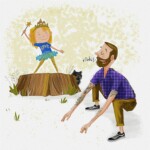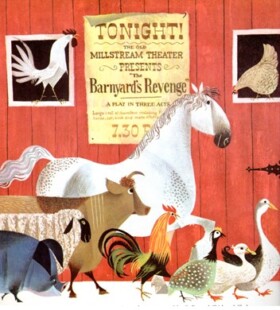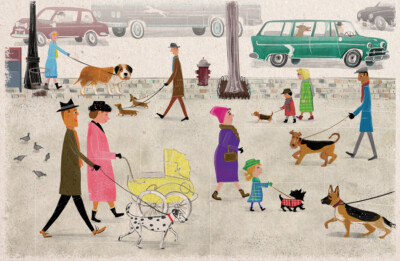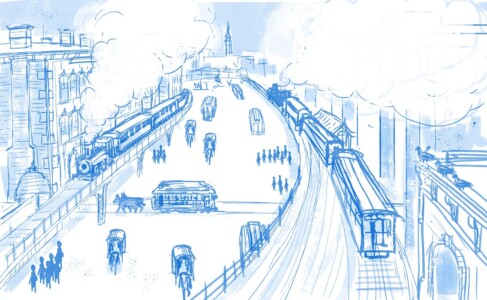Interview conducted by Kayla Hlad (she/her), MLIS Student, Kent State University
Dave Szalay is the current Illustrator-in-Residence at the Reinberger Children’s Library Center. Among other accomplishments, he is an award-winning illustrator with three published picturebooks (and counting). In this interview with Dave Szalay, learn about the illustrator’s style, artistic process, take on picturebook classics, and work with the center. Plus, join us as we celebrate the one year publishing anniversary of his recent picturebook with Lori Degman, Traveling with Monsters and get a sneak peak at his upcoming work.
Dave Szalay at a Glance

Illustrator, Designer, Aspiring Author, & Professor at the Myers School of Art at the University of Akron
Style: Dave Szalay uses digital drawing and painting techniques to add texture and value to his flat sketches of real and imagined characters and landscapes. Reviewers frequently describe Szalay’s work as “lively,” “humorous,” and “folksy” (check out his reviews on Kirkus Reviews and Publishers Weekly). Szalay himself describes his style as “nostalgic” and notes his inspiration from mid-20th century advertisements and picturebooks.
Medium & Tools: Cintiq digital pen display
Awards: Society of Children’s Book Writers & Illustrators (SCBWI) National Portfolio Showcase Honor Award, the Ohio Arts Council Individual Excellence Award for Illustration, and the Highlights Pewter Award for Best Illustration
Published Picturebooks Illustrated by Dave Szalay
Illustrations by Dave Szalay
An Interview with Dave Szalay
What does it mean to be an Illustrator-in-Residence at Kent State’s iSchool?
My appointment is a unique opportunity to share my experience as an active contributor to the world of children’s literature with future and current librarians who are the experts on curating and using published work. Having access to the Reinberger and Marantz collections allows me to immerse myself in the history of the craft. The authors and illustrators represented in the collections are the creative giants of my discipline whose shoulders I stand on.
Why did you become interested in becoming our Illustrator-in-Residence at this point in your career?
Initially the idea came at a time when I was planning my activities for a yearlong professional development leave from my teaching position. Having reached reasonable success as an illustrator, I planned on dedicating my time away from teaching toward leveling up my writing. The fact that this residency serves both writers and illustrators of picturebooks makes it a great fit for me.
Previously, you mentioned your interest in conducting scholarly research on storytelling with visual narratives by analyzing works in the Marantz and Reinberger collections at the Reinberger Children’s Library Center.
Could you tell us a little bit more about your research interests and your plans for work with the collection?
My hope is to revisit familiar work and to explore other work that I am less familiar with and view these examples through a different lens. The best way to engage with literature is to consume it, but I’d like to read and observe with the intention of identifying and categorizing elements such as story arcs, character development, and themes. There are also seven basic plots used universally in storytelling. I’ve never taken a comprehensive look at more than a few picturebooks at a time and considered how these factors contribute to the success of a book.
Are you planning any projects to connect with Kent State Students?
I am definitely interested in connecting with students. I think many of them could benefit from a behind the scenes look at my process and relationship to the publishing world. The pandemic has restricted us during this past year but I plan on offering some presentations as we return to some normalcy.
In previous interviews you mentioned that your grandmother’s sharing of “classic” picturebooks from her bookstore with you was a powerful memory and an initial spark for your love of illustration and picturebooks. Can you share some of the titles that you remember enjoying?
I still have many of them more than 50 years later.
My favorite was The Littlest Snowman by Charles Tazewell, illustrated by George DeSantis. I loved The Grinch Who Stole Christmas, by Dr. Seuss, and The Uncle Wiggily Book: The Rabbit Gentleman’s Adventures, by Howard R. Garis and illustrated by Carl and Mary Hauge. These were all oversized books, but I also had the miniature set of books by Beatrix Potter. That set reminds me of grandma the most because she seemed to really want me to like them. The Potter stories must’ve been meaningful to her too. I probably had at least 100 picturebooks in total.
What do you think turns picturebooks like these into classics?
The one thing these books all have in common are colorful, interesting, well developed characters. Each of them, in their own way, face and overcome the classic story arc conflict. They generally display strong will and personality. The old illustrations capture these traits well. They are genuine and authentic.
A couple I had mentioned are associated with a holiday season and I feel a well written picturebook associated with an ongoing tradition has an immediate sense of nostalgia. That’s comforting to a reader. Others I mention are over 100 years old at this point. Language has evolved quite a bit since these books were published so they may sound strange to young children although the characters and stories could be updated. An example is another one of my favorites, The Story of Ferdinand by Munro Leaf and exquisitely illustrated by Robert Lawson was brought back to younger audiences through a modernized animated feature. Good picturebooks seem to easily extend into other media outlets and can easily be updated to accommodate modern audiences.
You have previously noted that your illustrations are in part inspired by mid-20th century advertisements and classic picturebooks. What draws you to the illustrations from this time period and what elements have you carried over into some of your work?
There is a certain style reminiscent of that time. It’s a style that allows things to be a little wonky, and whimsical. It really appeals to my graphic design sensibilities. One of my mentor/teachers, the late illustrator, educator, and historian Murray Tinkelman, referred to it as the “decorative” style of illustration. It is a familiar style you see in a lot of vintage advertising and children’s books of the time. Many of these illustrators crossed into several forms of media such as ad work, kids books and animation.
In advertising Pushpin Studios, Bernie Fuchs, Lorraine Fox, Charley Harper, Cynthia Amrine, and Winnie Fitch represent an aspect of this style. My picturebook artist list is huge but to name a few examples I’d say, Mary Blair, Jan Balet, Bernice Myers, Miroslav Sasek, Alice and Martin Provensen, (Martin created Tony the Tiger) Aurelius Battaglia, and Ed Emberely, all applied a decorative style to their work. Although a little earlier, I must mention Virginia Lee Burton as having a major influence on me.
Decorative style has been around forever and can be found in Egyptian tomb art, Swedish and Eastern European folk art, Asian embroidery and Peruvian tapestries. Decorative illustration has an extremely efficient use of line, shape and color. I find the charm in the expression and imperfections, the deviation from formal, academic drawing.
What was your favorite picturebook to share with your two adult children when they were younger and what made them special?
Wow, that was such a long time ago, but I do remember sharing one of my childhood favorites, Go Dog Go, by P.D. Eastman. They really liked The Berenstain Bears and the Spooky Old Tree which we discovered together.
If you were to capture one moment in your life in a picturebook what would it be?

I have a story that has been a long time in-progress based on this photo (above). The working title is “The Day I Met Seymour.” I was enthralled with science fiction and space travel. Any time I was in my treehouse, had a big cardboard box or even a tent, it became a rocket ship, in my mind.
A Deeper look into Dave Szalay’s Process
Impressively, you recently have had three picturebooks published in just a one-year timespan: The Superlative A. Lincoln: Poems about our 16th President (November 2019, Charlesbridge), The True Story of Zippy Chippy: The Little Horse That Couldn’t (Feb. 2020, NorthSouth Books), and Travel Guide for Monsters (April, 2020, Sleeping Bear Press). Each has received incredibly positive reviews and are beautiful works of art. But I thought since we’re coming up on the one-year publishing anniversary for Travel Guide for Monsters, it would be a fun choice for a deeper look into your artistic process.
Would you mind taking us through your process for one of your illustrations in Travel Guide for Monsters?
I was so thrilled when I got the offer to illustrate a book that included monsters. I was about 7 years old when my grade school’s librarian, Mrs. Shaffer introduced me to Where the Wild Things Are. Those marvelous illustrations ignited a spark in me.

After reading the Travel Guide for Monsters manuscript, I knew this was a big yes. The combination of illustrating both monsters and also travel locations resonated. I pondered whether I should feature the same monster or create a new one for each location. I asked my art director Jennifer at Sleeping Bear and she said it was up to me. I decided to run with multiple monsters. I began to brainstorm by reading up mythological creatures from many cultures and listing physical attributes of monsters throughout history. I made lists of various monster features and began doodling. After I came up with a few ideas, I began storyboarding to develop a variety of compositions and set the visual pacing. This is when I came up with the idea of designing thematic frames and travel related icons around the edges. I always sketch books in side by side spreads as shown below.


My initial sketch (above) for the Everglades and New England coast spread was not approved. I was asked to show more action from both monsters. Show them playing Marco Polo on left and show the monster feasting on crabs and lobsters on right. Sketches were approved to go to color.

Once the new versions were presented, I was told there wasn’t enough drama, not enough action.

I was also asked to remove rocky coastline and replace with sand to feel like Nantucket, not Maine.

In this final round, I reimagined the monsters and created more interaction with their environments. This version was a big hit and made the final cut into the book.
Listen to Dave Szalay read Travel Guide for Monsters written by Lori Degman and illustrated by Dave Szalay (2020, Sleeping Bear Press).
Upcoming Work
I was so excited to hear that HarperCollins has bought the rights for a nonfiction picture book due to be published in Fall 2022 with Meghan Hoyt as the author and you as the illustrator. I can’t wait to learn about William J. Wilgus and his iconic Grand Central Terminal through this book. Congratulations!
Are you finding your process or style any different for illustrating a nonfiction title?
Thank you, and I actually have another biographical nonfiction book that has yet to be announced coming out in 2022. I like working in that space. There is not much difference in the planning and preparation as I always collect good reference material during the research phase. Regardless of the genre, I always incorporate quite a bit of stylization, however the degree of abstraction varies according to what I feel best serves the storytelling.
With nonfiction, I tend to pay closer attention to real-world details and give the work a slightly more figurative approach. With fiction, I feel I can take the whimsy and wonkiness up a notch if it fits. In two examples of my previous books, The True Story of Zippy Chippy, and The Superlative A. Lincoln, I put more effort into capturing the likeness and presence of the characters as well as the props and surroundings. I really enjoy the challenge of nonfiction work but it’s a balancing act because I don’t want to stray too far from my visual voice, yet I need to make sure it reflects the tone of the writing. I think the publishers do a good job of matching me up with books that fit my sensibilities.
I certainly can’t wait to see the results of this match.
I’ve heard that your illustrations are inspired by photographs that you personally take and/or find during your research. As a teaser for this upcoming work, could you leave us with an image that you’re finding inspiration in?
A huge thank you to Dave Szalay for sharing his insights on the world of children’s literature and providing an insider look on his process.
To learn more about Dave Szalay and his work, visit his website or follow him on Twitter.

